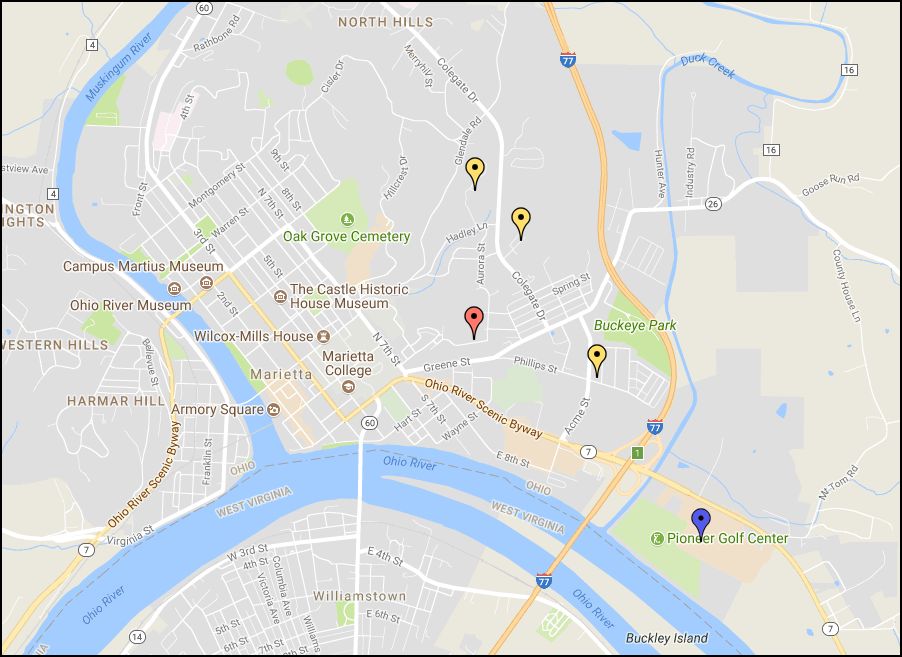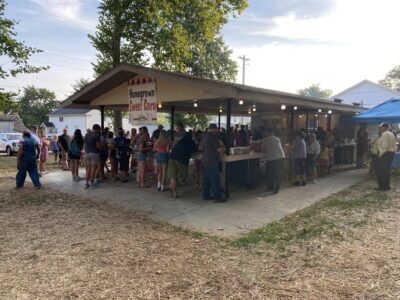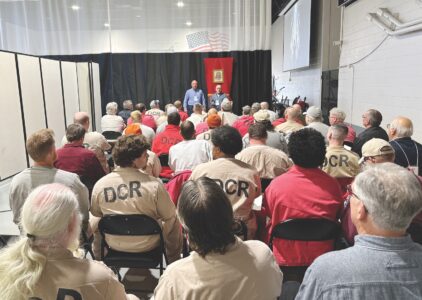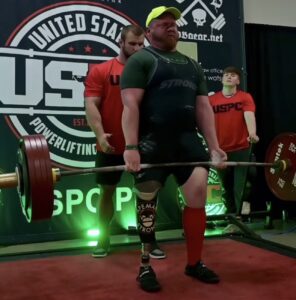Dangerous highs
Weekend ODs blamed for 1 death; officials wonder if there will be more

Graphic by Janelle Patterson The Marietta Times This map shows the locations of suspected overdose locations between Friday and Sunday.
After a weekend plague of overdoses, local officials caution families to stay vigilant.
“If you know somebody that is a user, get them some (naloxone) and make sure they’re in constant contact with you so that they don’t wind up deceased, ” said Marietta Police Capt. Aaron Nedeff.
He said the popular drug of choice right now, methamphetamine, may be making the rounds in the community laced with an opioid like heroin or fentanyl.
Six reports of possible overdoses were made to Marietta police and county law enforcement from Friday to Sunday, with one man dying from a suspected overdose. Five of the six reports were in Marietta.
That fatality was a 37-year-old Beverly man who died Friday at Marietta Memorial Hospital.
Four of the other reports also ended in hospital transport from the Marietta Police Department.
“There’s probably still more around here,” said Marietta Police Sgt. Ryan Huffman, of the drug mix.”The one (person) Saturday during the day responded to (naloxone) which means there is an opiate base in that meth, mixed in somehow.”
Mixing stimulants like methamphetamine with depressants like heroin and fentanyl is not a new concept, but it may be unexpected for those looking to get high solely off of meth.
“These drug cartels are trying to move product left from when heroin was popular. Now that meth is back on the rise they’re cutting it in,” said Nedeff. “It’s not surprising to see the mix of drugs.”
Regardless of if users are intentionally mixing the drugs, “speedballing,” the practice of combining methamphetamine with an opiate, can produce more extreme effects of the high, according to a study published by the U.S. National Library of Medicine National Institutes of Health.
The practice can also be used to diminish withdrawal effects.
“But a lot of people who just want to get messed up, who just want to get high in any form don’t really care how they get high,” said Nedeff. “But they’re in danger of going too far. We’re just trying to save some lives.”
The Ohio Department of Health released an advisory Monday noting a “continuing increase in fentanyl-related overdose deaths involving non-opioids like cocaine, methamphetamines (and) other psychostimulants.”
“Preliminary 2017 data indicates that 71 percent of all unintentional drug overdose deaths involved fentanyl or a fentanyl analogue. By comparison, 58 percent of overdose deaths did so in 2016, 37.9 percent in 2015, 19.9 percent in 2014, and 4 percent in 2013,” said the release. “Overdose deaths in which both fentanyl and methamphetamines/other psychostimulants were mentioned on the death certificate increased 142 percent from 2016 (117) to 2017 (283).”
Nedeff said local law enforcement is trying to track down this latest batch, but worries how many more deaths may come in the next few days.
“We’re attempting to find out where it’s coming from, but if the state put out an advisory you might as well take a map and draw an arrow to Columbus,” he said.
ODH said even though naloxone is not effective in treating drug overdoses caused solely by stimulants, the administration of naloxone may be helpful in drug overdoses caused by a combination of stimulants and opioids like fentanyl and its analogues.
“Encourage patients/clients who use illicit drugs, as well as their family and friends, to carry naloxone. Refer them to a local Project DAWN community-based naloxone education and distribution program, or refer them to a local pharmacy that dispenses naloxone,” said the release.
More information about where to obtain naloxone is available at http://www.odh.ohio.gov/odhprograms/naloxone/stopoverdoses.aspx
At a glance:
¯ Six overdose reports in Washington County were called into local law enforcement between Friday and Sunday.
¯ One person died from a suspected overdose.
¯ Local officials believe methamphetamine currently in circulation may be laced with heroin or fentanyl.
¯ Officials suggest families and friends of drug addicts procure naloxone in case of emergency.
Where to get naloxone:
Washington County pharmacies that distribute Naloxone without a doctor’s prescription:
¯ CVS, 1013 Washington Blvd., Belpre.
¯ CVS, 131 Third St., Marietta.
¯ Fruth Pharmacy, 1401 Washington Blvd., Belpre.
¯ Giant Eagle Pharmacy, 128 Gross St. in the Frontier Shopping Center, Marietta.
¯ Kroger Pharmacy, 40 Acme St., Marietta
¯ Kroger Pharmacy, 1008 Washington Blvd., Belpre.
¯ White Oak Pharmacy, 8465 State Route 339, Vincent.
¯ Rite Aid, 201 Washington Blvd., Belpre.
¯ Rite Aid, 301 Greene St., Marietta.
¯ Walgreens, 300 Greene St., Marietta.
Note: No pharmacies in Morgan, Monroe or Noble counties distribute Naloxone.
Local Project DAWN distribution sites:
¯ Washington County Health Department:
¯ 342 Muskingum Drive, Marietta.
¯ Call for an appointment for training at 740-374-2782.
¯ Morgan County Health Department:
¯ 4275 State Route 376, McConnelsville.
¯ Call for an appointment for training at 740-962-4572.
¯ Note: Morgan County only provides training and Naloxone kits for first responders.
¯ Noble County Health Department:
¯ 44069 Marietta Road, Caldwell.
¯ Call for an appointment for training at 740-732-4958.
¯ Note: Noble County only provides training and Naloxone kits for first responders.
¯ There is no site either at the Monroe County Health Department nor at a pharmacy in that county that provides Naloxone.
¯ More information on Project DAWN can be found at odh.ohio.gov/health/vipp/drug/ProjectDAWN.





